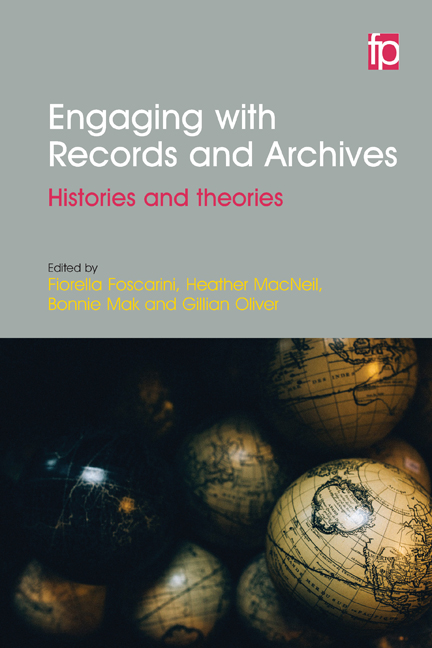Book contents
- Frontmatter
- Frontmatter
- Editors and contributors
- Editors’ introduction
- PART 1 RETHINKING HISTORIES AND THEORIES
- PART 2 ENGAGING RECORDS AND ARCHIVES
- 6 The use and reuse of documents by chancellors, archivists and government members in an early modern republican state: Genoa's Giunta dei confini and its archives
- 7 The bumpy road to transparency: access and secrecy in 19th-century records in the Dutch East Indies
- 8 Archival ethics and indigenous justice: conflict or coexistence?
- 9 History and development of information and recordkeeping in Malawi
- 10 History of community archiving in Poland
- 11 Reflecting on practice: artists’ experiences in the archives
- Index
11 - Reflecting on practice: artists’ experiences in the archives
from PART 2 - ENGAGING RECORDS AND ARCHIVES
Published online by Cambridge University Press: 08 June 2018
- Frontmatter
- Frontmatter
- Editors and contributors
- Editors’ introduction
- PART 1 RETHINKING HISTORIES AND THEORIES
- PART 2 ENGAGING RECORDS AND ARCHIVES
- 6 The use and reuse of documents by chancellors, archivists and government members in an early modern republican state: Genoa's Giunta dei confini and its archives
- 7 The bumpy road to transparency: access and secrecy in 19th-century records in the Dutch East Indies
- 8 Archival ethics and indigenous justice: conflict or coexistence?
- 9 History and development of information and recordkeeping in Malawi
- 10 History of community archiving in Poland
- 11 Reflecting on practice: artists’ experiences in the archives
- Index
Summary
IT IS NOW MORE than a decade since attention was drawn to the presence of a distinct archival impulse in contemporary art (Foster, 2004). This chapter examines how the practices of the archive and archiving have been encountered and reframed by contemporary artists. As well as the artistic practice there is a growing body of literature in which it is receiving critical attention. However, as Breakell (2011) notes, the majority of publications on art and archives tend to focus on the artists and critical theorists and do not include writings by archivists. The example she gives is The Archive (Merewether, 2006), a compilation of texts on the subject by 30 different authors, not one of whom is an archive professional (Breakell, 2011, 35). This chapter explores what can be learned from reflecting on artists’ practice with archives from a perspective that combines within and without the archival field. It explores the theorizing of archives through practice by artists via one particular thread of artists’ engagement with archives – artists’ experiences with archives where the subject matter itself is art.
The artist-in-residency model is examined through Bob and Roberta Smith at the Epstein Archive at The New Art Gallery Walsall. The commission was to reawaken an archive and the project also set out to explicitly explore new ways of collaborating between an artist and an archivist. What, if indeed anything, can be learned in terms of theory and practice by professional archivists from such creative artistic activations of the archives? Brixton Calling! was a collaborative, participatory project to explore and archive the history of Brixton Art Gallery and Artists’ Collective in London in the 1980s, initiated by former members of the Collective. The self-conscious mediation of legacy through archive creation exhibited in the Brixton Calling! project can be seen as symptomatic of a wider and cultural archival consciousness Using as a lens the particular and self-referential perspective of artists on archives of art practice, can we learn more about the wider archival trend towards participatory practice?
The archival impulse in contemporary art
Over a decade ago, prominent art critic and historian Hal Foster drew attention to the presence of a distinct archival impulse in contemporary art as artists sought to make historical information, often lost or displaced, physically present by reorganizing bodies of alternative knowledge or counter-memory (Foster, 2004).
- Type
- Chapter
- Information
- Engaging with Records and ArchivesHistories and Theories, pp. 211 - 232Publisher: FacetPrint publication year: 2016
- 3
- Cited by



